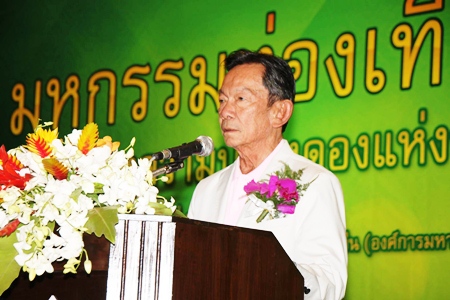A government proposal to designate Pattaya as a special area for sustainable development got its first public forum this month, with Thailand’s deputy prime minister backing a plan that could see the area receive 10 billion baht in funding.
Deputy Prime Minister Maj. Gen. Sanan Kajornprasart, who oversees the Designated Areas for Sustainable Tourism Administration, (DASTA) was among the political leaders at the January 19 meeting at Nong Nooch Tropical Garden. He was joined by Mayor Itthiphol Khunplome, Chonburi Governor Wichit Chatpaisit and top Bangkok bureaucrats in reviewing a three-year national plan to designate as many as 13 regions as sustainable tourism destinations.
 Maj. Gen. Sanan Kajornprasart, sees sustainable tourism as road to peace and reconciliation.
Maj. Gen. Sanan Kajornprasart, sees sustainable tourism as road to peace and reconciliation.
Sanan said he sees tourism promotion as one of the steps in the ruling Democrat Party’s “reconciliation” plan to hear cultural and political divisions that resulted in deadly riots last year. Among the sub-projects the deputy premier envisions are networks devoted to environmentalists, youth, media and tourism businesses.
What it may really turn out to be, however, is a windfall for local politicians who stand to benefit from billions of baht in government spending on their pet projects.
Pattaya’s five-year pursuit of government funding to solve its many environmental, infrastructure, crime and tourism woes began with an application for DASTA recognition in May 2008, although city officials had been trying out since 2005 how to meet the program’s discerning qualifications.
Set up by a 2003 royal decree, DASTA was given a mission to integrate and oversee tourism development in areas designated to have superb natural environments, cultural and traditional importance and have been developed for tourism purposes. Among the first projects approved were Koh Chang National Park, the Chiang Mai Night Safari, Koh Lanta, Koh Samet and the Nongteng-Chakkarat forest in Nakhon Ratchasima.
With its sprawling nighttime industry and many environmental problems, Pattaya’s bids for DASTA status – and the millions in baht that come with it for mayoral pet projects – were repeatedly turned away. But in July 2008 Bangkok officials conceded, admitting Pattaya formed a “distinctive” area for international tourism and could retain its status as a draw for foreign currency if developed properly.
Thus began nearly three years of discussions and proposals that culminated in 29 public hearings and private meetings and the March 2009 designation of a 928 sq. km. zone that comprising Pattaya and the eight districts. In the middle of last year, the DASTA board hired four consultancy firms to draw up the proposed master plan addressed this month.
More public hearings will need to be held before the plan is submitted to the Cabinet. Only if approved would the city start to see funds.




